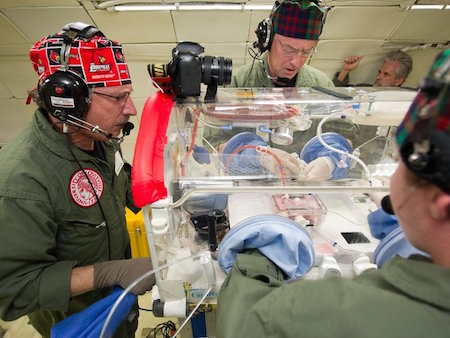Science Fiction
Dictionary
A B C D E F G H I J K L M N O P Q R S T U V W X Y Z
Surgery In Space

NASA surgeons have long pondered whether or not surgery in space is possible; it was tried by surgeon Mark Campbell in the "Vomit Comet" in 1991 with an anesthetized and restrained rabbit under micro-G conditions.

(Micro-G surgery a difficult option)
Campbell ignores the sensation of weightlessness as he takes a scalpel and carefully opens the rabbit’s carotid artery, then pulls back to watch. Initially, Campbell sees exactly what he expects. In zero gravity, bright red globes of blood streak out of the wound like paint balls fired from a gun.But within seconds, the steady flow of globes diminishes and then stops while a dome of blood grows over the incision. Dismayed, Campbell makes his carotid incision larger to increase blood flow but the results are unchanged, and a cut into a major artery in the rabbit’s abdomen has the same result. “Finally we just figured out that that’s the way blood acts in weightlessness,” he says. “It didn’t act the way we thought it would.”
Currently, the International Space Station keeps a spare Russian Soyuz capsule for use as an ambulance in case surgery is needed.
Larry Niven thought carefully about this problem in his 1970 blockbuster novel Ringworld:
But they got him into the autodoc anyway. It was a puppeteer-shaped coffin, form-fitted to Nessus himself, and bulky Puppeteer surgeons and mechanics must have intended that it should handle any conceivable circumstance. But had they thought of decapitation? They had. There were two heads in there, and two more with necks attached, and enough organs and body parts to make several complete puppeteers. Grown from Nessus himself, probably; the faces on the heads looked familiar.
(Read more about Larry Niven's autodoc)
Other science-fictional options are also enclosed, like the crechpod from Frank Herbert's 1972 novel The Godmakers. Open models, like the diagnostat from Robert Silverberg's wonderful 1969 novel The Man in the Maze, are not used in space. Via AirSpaceMag.
Scroll down for more stories in the same category. (Story submitted 8/21/2015)
Follow this kind of news @Technovelgy.| Email | RSS | Blog It | Stumble | del.icio.us | Digg | Reddit |
Would
you like to contribute a story tip?
It's easy:
Get the URL of the story, and the related sf author, and add
it here.
Comment/Join discussion ( 0 )
Related News Stories - (" Medical ")
Natural Gait With Prosthetic Connected To Nervous System
'The leg was to function, in a way, as a servo-mechanism operated by Larry’s brain...' - Charles Recour, 1949.
Brain Implant Is Able To Capture Your Inner Dialogue
'So you see, you can hide nothing from me.'
'Pregnancy Humanoids' From China Replace Moms
'A great many of these synthetic babies were made...' - David H. Keller, 1928.
Bacteria Turns Plastic Into Pain Relief? That Gives Me An Idea.
'I guess there's nobody round this table who doesn't have a Crosswell [tapeworm] working for him in the small intestine.'
Technovelgy (that's tech-novel-gee!) is devoted to the creative science inventions and ideas of sf authors. Look for the Invention Category that interests you, the Glossary, the Invention Timeline, or see what's New.
Science Fiction
Timeline
1600-1899
1900-1939
1940's 1950's
1960's 1970's
1980's 1990's
2000's 2010's
Current News
Sunday Robotics 'Memo
'He then started hand movements of definite pattern...'
Woman Marries Computer, Vonnegut's Dream Comes True
'Men are made of protoplasm... Lasts forever.'
Natural Gait With Prosthetic Connected To Nervous System
'The leg was to function, in a way, as a servo-mechanism operated by Larry’s brain...'
Spidery 'Walk Me' Toyota Autonomous Wheel Chair Like Star Wars
Walk along with the emperor.
Dancing Robots Taught Dance Moves
'A clockwork figure would be the thing for you...'
Proof Of Robothood - Not A Person
'Who are you people? - Show 'em.'
Indonesian Clans Battle
'The observation vehicle was of that peculiar variety used in conveying a large number of people across rough terrain.'
The 'Last Mile' In China Crowded With Delivery Robots
Yes, it's a delivery robot. On wheels.
Tornyol Microdrone Kills Mosquitoes
'The real border was defended by... a swarm of quasi-independent aerostats.'
PLATO Spacecraft, Hunter Of Habitable Planets, Now Ready
'I ... set my automatic astronomical instruments to searching for a habitable planet.'
Factory Humanoid Robots Built By Humanoid Robots
'...haven't you a section of the factory where only robot labor is employed?'
iPhone Air Fulfils Jobs' Promise From 2007 - A Giant Screen!
'... oblongs were all over the floor and surfaces.'
ChatGPT Now Participates in Group Chats
'...the city was their laboratory in human psychology.'
iPhone Pocket All Sold Out!
'A long, strong, slender net...'
Did The Yautja Have These First?
What a marvel of ingenuity the little device was!
Jetson ONE Air Races Begin, Can Air Polo Be Far Behind?
'If you're one of those rarities who haven't attended a rocket-polo "carnage", let me tell you it's a colorful affair.'
